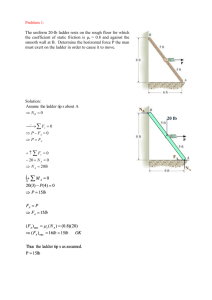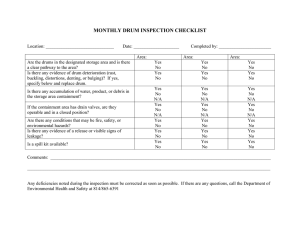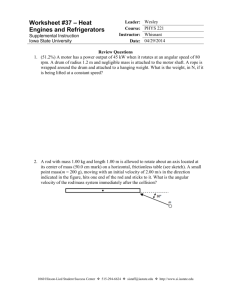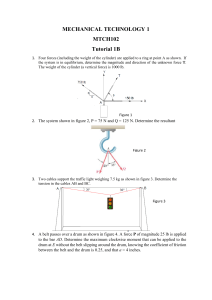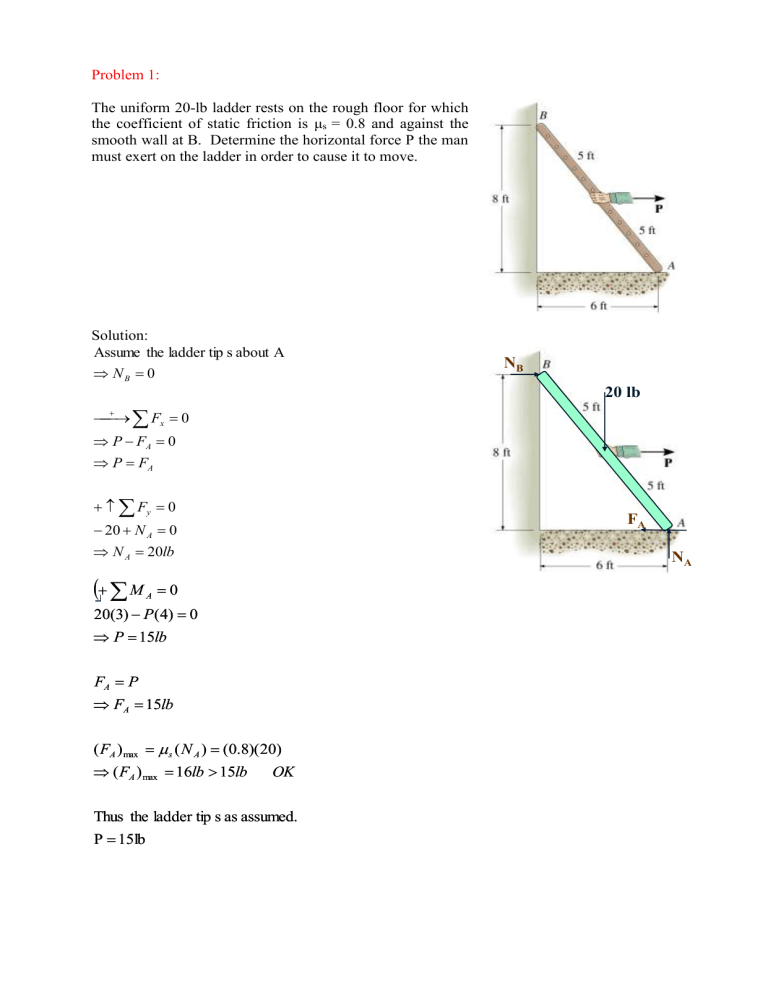
Problem 1: The uniform 20-lb ladder rests on the rough floor for which the coefficient of static friction is μs = 0.8 and against the smooth wall at B. Determine the horizontal force P the man must exert on the ladder in order to cause it to move. Solution: Assume the ladder tip s about A NB 0 NB 20 lb Fx 0 P FA 0 P FA Fy 0 FA 20 N A 0 N A 20lb M A NA 0 20(3) P (4) 0 P 15lb FA P FA 15lb ( FA ) max s ( N A ) (0.8)( 20) ( FA ) max 16lb 15lb OK Thus the ladder tip s as assumed. P 15lb Problem 2: A drum has a weight of 100 lb and rests on the floor for which the coefficient of static friction is μs = 0.5. If a = 3ft and b = 4 ft, determine the smallest magnitude of the force P that will cause impeding motion of the drum. Solution: Assuming that the drum slips, we first draw FBD and solve for the unknown: Fx 0 4 0 .5 N P 0 5 8 N P 5 P 3 5 4 100 lb 1.5 ft 1.5 ft 4 ft Fy 0 3 P 100 N 0 5 3 8 P 100 P 0 5 5 P 100lb 8 N 100 160lb 5 M O 0 3 4 160( x) 100 (1.5) 100 (4) 0 5 5 x 1.44 ft 1.5 ft OK Drum slips as assumed Since x is smaller than the radius of the drum, the calculated value of P is the smallest magnitude of force for impending motion of the drum. F=sN x N Problem 3: A force P=20 lb is applied perpendicular to the handle of the gooseneck wrecking bar as shown. If the coefficient of static friction between the bar and the wood is μs = 0.5, determine the normal force of the tines at A on the upper board. Assume the surface at C is smooth. Solution: We start with the FBD and write the force equilibrium equations and moment equation about point C: Fx 0 P = 20lb 20 cos 30 FA 0 FA 17.32lb M C 0 NA FA N A (3) (17.32)(1) 20 cos 30( 20) 20 sin 30(6) 0 N A 129.7lb 130lb Fmax ( s )( N A ) Fmax 0.5(129.7 ) 64.8lb 17.32lb The bar won' t slip NC Problem 4: The uniform 6-kg slender rod rests on the top center of the 3-kg block. If the coefficients of static friction at the points of contact are μA = 0.4, μB = 0.6, and μC = 0.3, determine the largest couple moment M which can be applied to the rod without causing motion of the rod. Solution: Rod : Fx 0 FB N C 0 FB N C (1) Fy 0 N B FC 58.86 0 M B ( 2) 0 FC (0.6) N C (0.8) M 58.86(0.3) 0 Box : FC (3) Fy 0 6(9.81)=58.86N N A N B 29.43 0 (4) Fx 0 FA FB 0 FA FB M O (5) 0 FB FB (0.3) N B ( x ) 29.43( x) 0 (6) Assuming slipping occurs at point C and the block tips FC = μs(C) NC = 0.3 NC and x = 0.1 m. Substituting these values into equations (1) through (6): M 8.561N .m 8.56 N .m N B 50.83N N A 80.26 N FA FB N C 26.75 N FC 0.3N C 0.3(26.75) 8 N Since (FA)max = μs(A) NA = 0.4 (80.26) = 32.11 N (FA)max =32.11 N > FA = 26.75 N, The block does not slip. Also, (FB)max = μs(B) NB = 0.6 (50.83) = 30.50 N (FB)max =30.50 N > FB = 26.75 N, Hence, slipping does not occur at point B. The assumption that slipping occurs at C is correct. NB NB FB 3(9.81)=29.43N 0.3m O NA x FA NC
